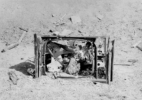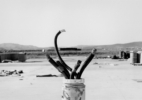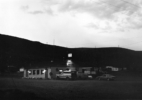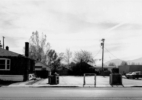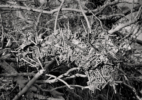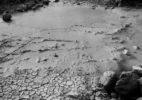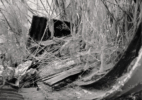Desert of Disintegration
September 16 - November 4, 2006
Gallery Luisotti is pleased to announce the exhibition Lewis Baltz – Desert of Disintegration. Focused on three key portfolios, “Nevada” (1978), “San Quentin Point” (1983), and “Near Reno” (1986), and selected individual works from that period, Desert of Disintegration represents the middle of Baltz’s career. With his multi-image portfolios of the 1970s, Lewis Baltz became known for his objective depiction of an increasingly manufactured landscape. As Baltz once claimed, “it might be more useful, if not necessarily more true, to think of photography as a narrow, deep area between the novel and film.” The works represented in Desert of Disintegration represent the pinnacle of that photographic process, as each portfolio presents a distinct location through precisely selected images of that place. Expanding his interest in the man-altered landscape, these key later works consider the disintegration of westward expansion through meticulously processed images of detritus in the landscape.
In 15 images “Nevada” reads the landscape like a Western motion picture. Out of it a near iconic image of western Americana emerges: a bar-room with a pick-up truck parked out front at sundown. Yet the same series presents a decisively violent moment: a fluorescent tube left on a dirt path, crushed in its mid-section. The image is stark, presenting the technological as destroyed in the wilderness. The photograph underpins Baltz’s work from that point on; it senses that westward expansion has turned on itself in an entropic cannibalism.
Five years later, in his portfolio “San Quentin Point,” Baltz shows a keen awareness of the escalating degradation of ecologically sensitive areas . In this series of stunningly crisp images, one finds garbage and unidentifiable refuse in differing states of biodegradation. Yet they are also in a state of techno-degradation; these otherworldly landscapes depict the meeting point of destroyed biology and the disregarded waste of a technologically advanced society.
In one of his final works created in the United States, Baltz’s “Near Reno” is a succession of silvery white exurban spaces surrounding an urban, tract home infrastructure. Baltz depicts Reno as a no-man’s land, built in an inhospitable high desert locale. Shooting shot materials, the images in “Near Reno” portray improvised firing ranges and roadside banalities. “Near Reno” captures the microscope and the overlooked to deliver and uneasy portrayal of life in the desert West.
Surrounding these images, select images made in Italy, France and British Columbia complete Baltz’s vision of the period 1977-86. Filled with want and waste, Baltz’s mid-career photographs portray an unsettling, continually rebuilt landscape. Motifs repeat through these works, all laid out on a desert of disintegrated progress.


